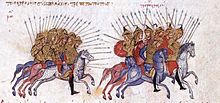Theophilos (emperor)
| Theophilos | |
|---|---|
Amorian dynasty | |
| Father | Michael II |
| Mother | Thekla |
Amorian dynasty | ||
|---|---|---|
| Chronology | ||
|
||
| Succession | ||
|
||
Theophilos (
Life
Early

Theophilos was the son of the

Theophilos continued in his predecessors' iconoclasm, though without his father's more conciliatory tone,[2] issuing an edict in 832 forbidding the veneration of icons.[10] He also saw himself as the champion of justice, which he served most ostentatiously by executing his father's co-conspirators against Leo V immediately after his accession.[9]: 2066

War against the Arabs

At the time of his accession, Theophilos was obliged to wage wars against the

During the respite from the war against the Abbasids, Theophilos arranged for the abduction of the Byzantine captives settled north of the
In 837 Theophilos led a vast army of 70,000 men towards
Afshin withstood the Byzantine attack, counter-attacked, and won the battle. The Byzantine survivors fell back in disorder and did not interfere in the caliph's continuing campaign.
Al-Mu'tasim took

In 838, in order to impress the Caliph of
Around 841, the Republic of Venice sent a fleet of 60 galleys (each carrying 200 men) to assist the Byzantines in driving the Arabs from Crotone, but it failed.[19] During this campaign Al-Mu'tasim discovered that some of his top generals were plotting against him. Many of these leading commanders were arrested and some executed before he arrived home. Al-Afshin seems not to have been involved in this, but he was detected in other intrigues and died in prison in the spring of 841. Caliph al-Mu'tasim fell sick in October 841 and died on 5 January 842.
It is said that Theophilos, even though fighting the Arabs built a Baghdad-style palace near the Bosporus. In those days people went about a l'arabe in kaftans and turbans. Even as far as in the normal streets of Ghuangzhou during the era of Tang, the Arab-style kaftan was in fashion.[20][relevant?]
Relations with Bulgaria and Serbia

In 836, following the expiration of the
The peace between the
Khan
Death and legacy
The health of Theophilos gradually failed, and he died on 20 January 842.

Family

By his marriage with Theodora, Theophilos had seven children, two sons and five daughters:
- Constantine (c. 830 – c. 836). Co-emperor from c. 833 to c. 836. He drowned because a domestic incident.
- regencyof her mother. Later exiled to a monastery by her brother Michael.
- Anna (b. c. 832). Exiled into the monastery of Gastria when she died.
- Anastasia (b. c. 833). Exiled into the monastery of Gastria when she died.
- Pulcheria (born c. 836). Exiled into the monastery of Gastria when she died.
- Maria (b. c. 838). She was bethored to the Caesar Alexios Mosele. Exiled into the monastery of Gastria before of her sisters and died before their exile.
- Michael III (840 – 867), who succeeded as emperor.
See also
Notes
- ^ Theophilos's age is discussed here - https://grbs.library.duke.edu/article/viewFile/8531/4731
- ^ a b c d Timothy E. Gregory (2010). A History of Byzantium. Blackwell Publishing Ltd. p. 227.
- ISBN 978-0761836247.
- ^ Grierson 1973, p. 387.
- ^ Bury 1912, p. 80.
- ^ Signes Codoñer 2016, p. 73.
- JSTOR 1291437.
- ^ PmbZ, Michael II: Chronicon Altinate
- ^ ISBN 0-19-504652-8.
- ^ a b c d Chisholm 1911, p. 786.
- ^ J. Norwich, Byzantium: The Apogee, 47
- ^ I. Sevcenko, Review of New Cambridge History of the Byzantine Empire, Slavic Review, p. 111, 1968.
- ^ W. Treadgold, A History of the Byzantine State and Society, 440
- ^ The claim that Sozopetra or Arsamosata was Mu'tasim's native city is found only in Byzantine sources. This claim is dismissed by most scholars as a later invention, i.e. as a parallel to Amorium, the likely birthplace of Theophilos. It was probably added deliberately to balance and lessen the effect of the blow that the latter's fall represented. Bury 1912, p. 262 (Note #6); Treadgold 1988, p. 440 (Note #401); Vasiliev 1935, p. 141. Kiapidou 2003, Note 1.
- ^ J. Haldon, The Byzantine Wars, 83
- ^ W. Treadgold, A History of the Byzantine State and Society, 441
- ^ J. Norwich, Byzantium: The Apogee, 43
- ^ Signes Codoñer 2016, pp. 316–320.
- ^ J. Norwich, A History of Venice, 32
- ISBN 978-0-300-18235-4.
- ^ a b c d Bury 2008, p. 372
- ^ L. Kovacevic & L. Jovanovic, Историја српскога народа, Belgrade, 1894, Book 2, pp. 38—39
- ^ S. Stanojevic, Историја српскога народа, Belgrade, 1910, pp. 46—47
- ^ a b Известия за българите, pp. 42—43
- ^ Fine 1991, p. 108
- ^ Fine 1991, p. 110
- ^ Runciman 1930, p. 88
- ^ Houtsma 1993, p. 199
- ^ Bekker, Immanuel, ed. (1838). "Libri III: 41". Theophanes Continuatus. p. 139.
Paucos hinc dies vitae superstes vigesima die Ianuarii naturae debitum solvit, imperio potitus annos duodecim menses tres.
References
- Chisholm, Hugh, ed. (1911). . Encyclopædia Britannica. Vol. 26 (11th ed.). Cambridge University Press. pp. 786–787.
- Bury, J. B. (1912). History of the Eastern Empire from the Fall of Irene to the Accession of Basil: A.D. 802–867. Cosimo. ISBN 1605204218.
- ISBN 0-472-08149-7.
- Grierson, Philip (1973). Catalogue of the Byzantine Coins in the Dumbarton Oaks Collection. Vol. 3. ISBN 978-0884020455.
- John Bagot Glubb The Empire of the Arabs, Hodder and Stoughton, London, 1963
- Haldon, John (2008). The Byzantine Wars. The History Press.
- ISBN 978-0-7914-0493-5.
- Runciman, Steven (1930). A history of the First Bulgarian Empire. London: G. Bell & Sons.
- Signes Codoñer, Juan (2016). The Emperor Theophilos and the East: Court and Frontier in Byzantium during the Last Phase of Iconoclasm. Routledge. ISBN 978-1317034278.
- ISBN 0-8047-2630-2.
- ISBN 978-0-8047-1462-4.
- OCLC 181731396.
